Here is how you can change the DPI display scaling in Windows 11. Increasing or decreasing the display scaling in Windows 11 is how you make UI elements in Windows 11 smaller or bigger. Windows 11 calculates the scaling factor for your monitor automatically, that may not follow you preferences, especially if you have a large display with a high resolution.
Advertisеment
Modern devices often include high resolution displays. Even if you have got a small Ultrabook or a Windows tablet, its display resolution can be 1080p or more. Or you may have a desktop monitor with 4K resolution. In this case, Windows 11 will automatically adjust DPI scaling so everything on your screen becomes larger.
DPI stands for Dots per inch. It is the physical measurement of number of pixels in a linear inch of a display. DPI defines a scale factor that Windows uses to resize the running apps and documents. Today, most popular scaling factors are in range 96-125 DPI.
Let's review how to change Display Scaling in Windows 11.
Change DPI Display Scaling in Windows 11
You can adjust the DPI scaling level on Windows 11 using a number of methods. First of all, Windows 11 allows changing it via the Settings app. Secondly, you can configure it directly in the Registry.
Change DPI in Windows 11 using Settings
- Right-click the Start menu button and select Settings. Alternatively, press the Win + I shortcut.
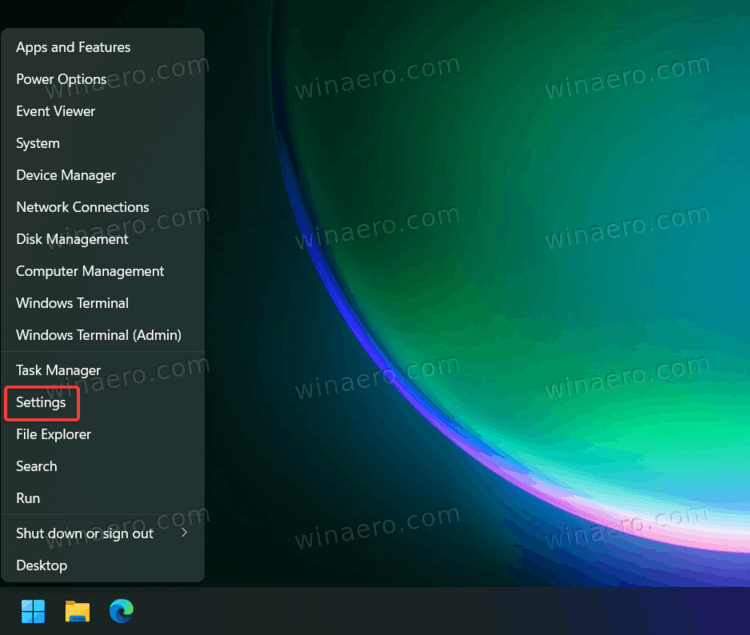
- Go to the System section and click the Display button. You can also get there directly by right-clicking the desktop and selecting Display Settings.
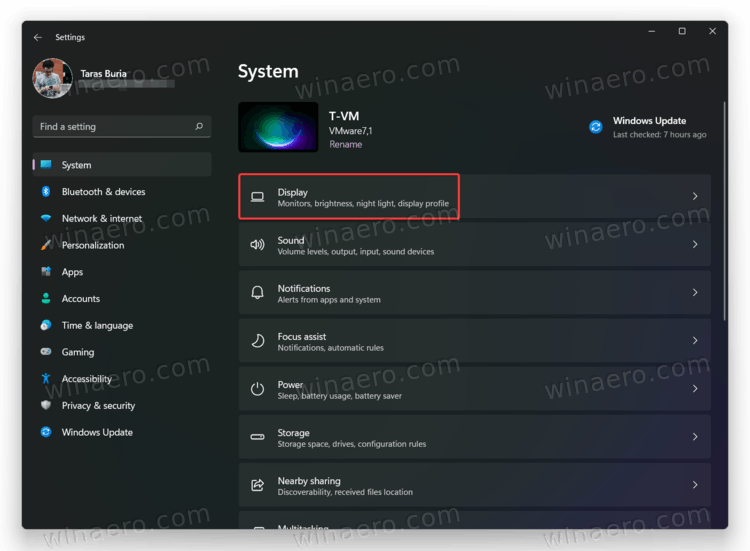
- Find the Scale option and pick a new value from a drop-down list.
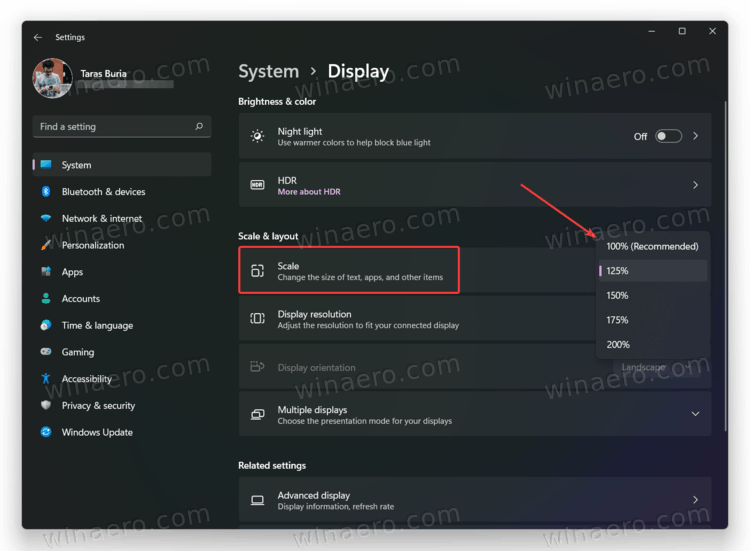
- Windows 11 will instantly apply the new DPI scaling value.
Note that the number of available scaling options depends on your monitor size and resolution. The Recommended percentage value is the default scale size. Also, you may be unable to change the display scaling in Windows 11 if a GPU driver is missing.
Windows 11 applies the new scaling immediately and without the need to restart the system or sign out of your profile. Still, you might need to reopen some apps that do not support per-monitor DPI-awareness version 2. You can read more about how to find DPI-aware apps in Windows 11 in our dedicated article. It also describes various DPI-awareness states and how apps behave in them.
Set custom scaling in Windows 11
If the default scaling values do not fit your taste and you need something in-between, Windows 11 allows setting a custom display scaling.
To set a custom DPI for the display scaling level, do the following.
- Right-click the desktop and then select Display Settings.
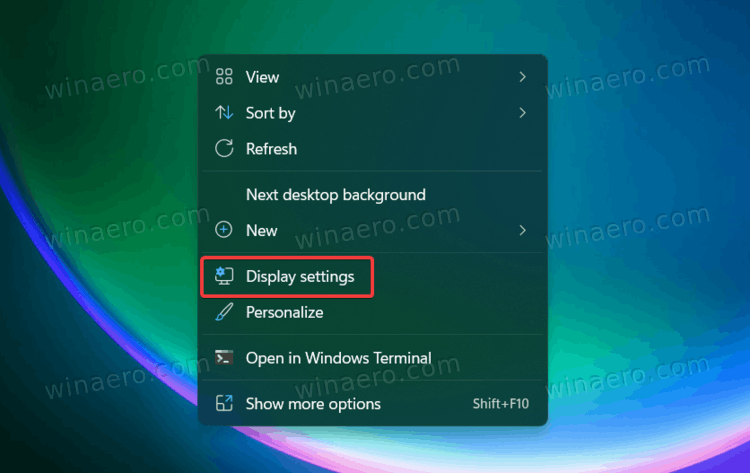
- Click the Scale section.
- Find the Custom Scaling option and enter the value you need between 100 and 500%.
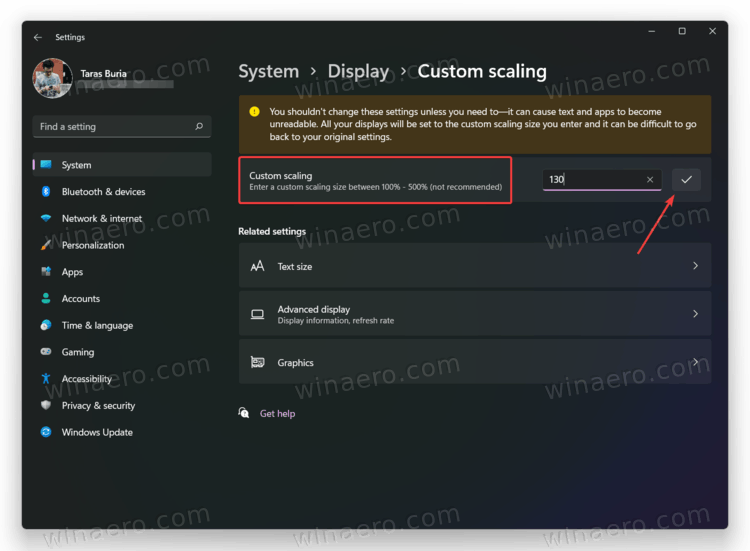
- Click the button with a checkmark to apply changes.
- Click the Sign out now link.
You are done. Unlike default scaling options, you need to sign out and sign back in when enabling or disabling custom scaling in Windows 11.
Note: When setting a custom scaling level, you might get poor image rendering in some apps, as some of them may not support this feature properly. Also, if use a huge scaling factor, some of the controls and buttons may disappear from screen or overlap with other elements. The safest option is to set values between those available in the scaling drop-down list described earlier.
Finally, if you need to adjust the display scaling and DPI in a Registry tweak, it is also possible. The next chapter describes the procedure in detail.
Change display scaling in the Registry
- Launch Registry Editor using the Win + R shortcut and the
regeditcommand. - Go to
HKEY_CURRENT_USER\Control Panel\Desktop. You can copy the path and paste it into the address bar in Windows Registry Editor.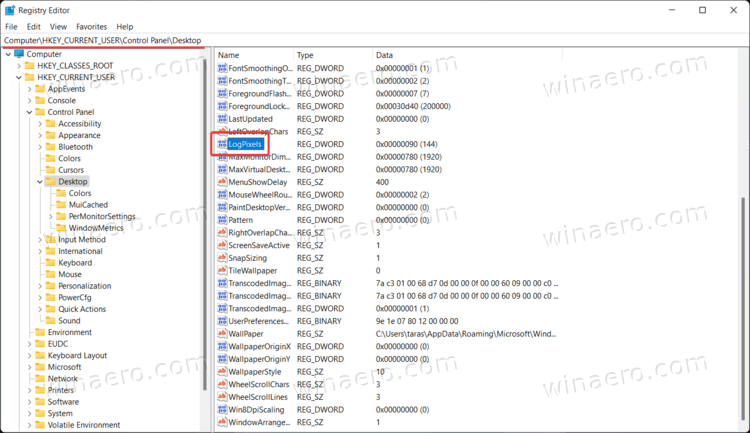
- Find the "
LogPixels" value and edit it. - Switch the Base option from Hexadecimal to Decimal.
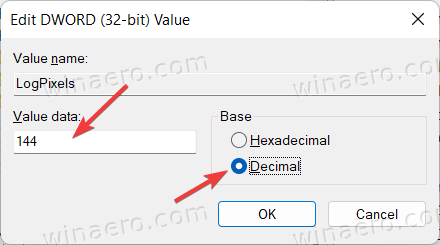
- Change the its value data to one of the following numbers:
- 96 = default 100%
- 120 = medium 125%
- 144 = larger 150%
- 192 = extra-large 200%
- 240 = custom 250%
- 288 = custom 300%
- 384 = custom 400%
- 480 = custom 500%
- Next, find the
Win8DpiScalingvalue and open it. Set its value data to 1 if you use LogPixels value other than 96.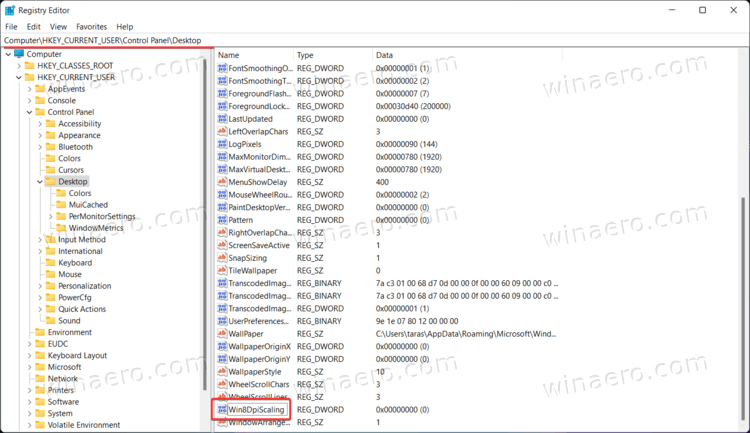
- Restart Windows 11 to apply changes.
You are done.
If you want to restore default changes, use a prebuilt registry file. It will let you reset custom scaling in Windows 11 with a single click.
That's it!
Support us
Winaero greatly relies on your support. You can help the site keep bringing you interesting and useful content and software by using these options:

Even today, I still see things not scaling properly in Windows 11. I was installing something the other day and all the install windows were blurry and/or fuzzy. Contrast this to a Mac that I also use, and Apple seems to have made better progress in MacOS and scaling. It’s why I still prefer to use Windows on a PC where I don’t need to scale up and stay at 100% scale setting.
I used to use the RegEdit option to have a custom, smaller DPI setting to have a similar screen space of a 1080p display on my 768p laptop, but the latest W11 update broke this workaround. Is there any alternative method?
@JohniL
Thank you! I noticed this too. Ever so slightly starting with Windows 8, made a bit worse with Windows 10, and now Windows 11 it’s the worst when I to Windows Settings or the Windows Start menu. Everything is typically fine with most other apps.
The only option is to increase the scaling to 125% but that’s ridiculously large even on a 32 inch monitor. Too bad we can’t scale like we could before in Windows 7 and use the slider to adjust the scaling.
I would love it if there was a way to toggle between 2 scaling options from the taskbar, I use 100% sat at my desk and 150% when laid in bed. There doesn’t seem to be an easy way to do this.
It pisses me off that there’s apparently no way to change the DPI for individual programs.
me. WTF was Microsoft even THINKING to change the ability to do this? Not everyone is 18 and had 20/20 eyesight, FFS!!!!
I want the abilty to finely tune and customize my display options BACK. The OS is nearly dysfunctional like this! I constantly am either unable to read some if not all windows and/or having app windows that roll off screen when you have button that need to be pushed to perform some action (like, this frequently happens to me on installations and updates!)
I WANT MY DISPLAY OPTIONS BACK, DAMMIT! THIS “NEW” (supposedly easier) OPTION IS BROKEN! (AKA FUBAR)